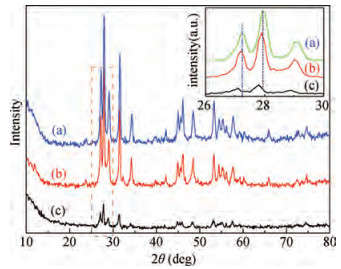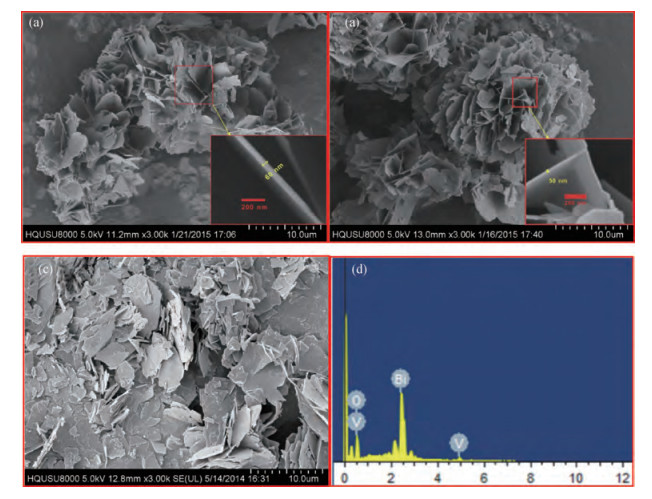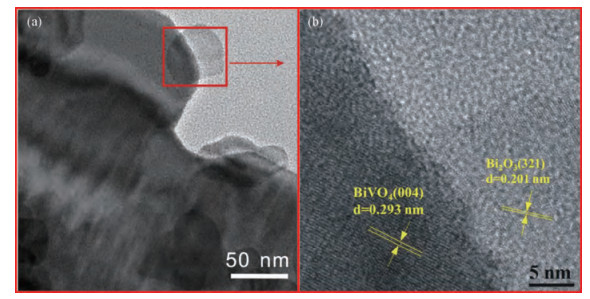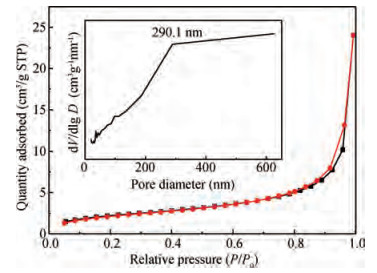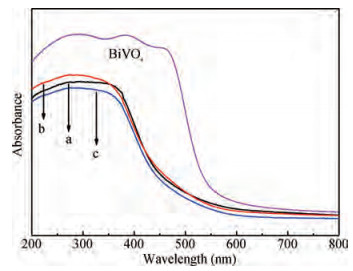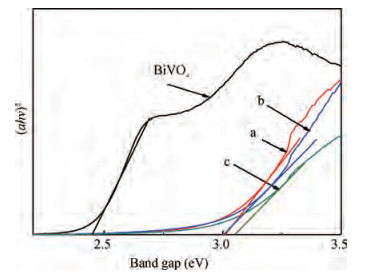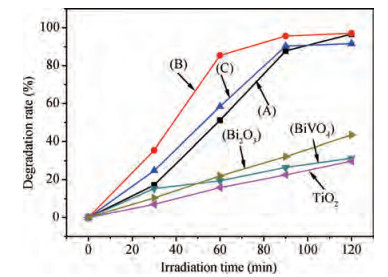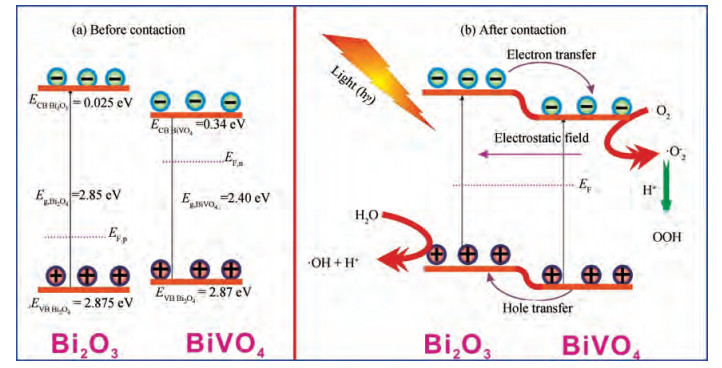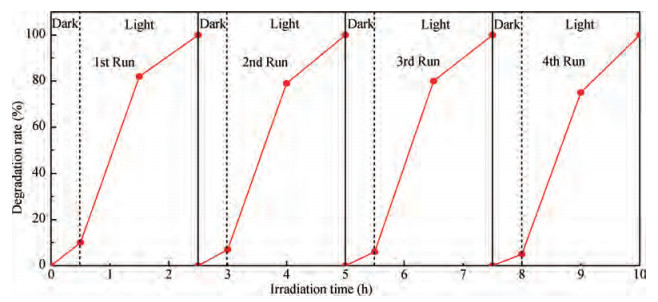| Citation: |
Ying Wu, Jing Wang, Yunfang Huang, Yuelin Wei, Zhixian Sun, Xuanqing Zheng, Chengkun Zhang, Ningling Zhou, Leqing Fan, Jihuai Wu. Solvothermal synthesis of Bi2O3/BiVO4 heterojunction with enhanced visible-light photocatalytic performances[J]. Journal of Semiconductors, 2016, 37(8): 083004. doi: 10.1088/1674-4926/37/8/083004
****
Y Wu, J Wang, Y F Huang, Y L Wei, Z X Sun, X Q Zheng, C K Zhang, N L Zhou, L Q Fan, J H Wu. Solvothermal synthesis of Bi2O3/BiVO4 heterojunction with enhanced visible-light photocatalytic performances[J]. J. Semicond., 2016, 37(8): 083004. doi: 10.1088/1674-4926/37/8/083004.
|
Solvothermal synthesis of Bi2O3/BiVO4 heterojunction with enhanced visible-light photocatalytic performances
DOI: 10.1088/1674-4926/37/8/083004
More Information
-
Abstract
Novel, three-dimensional, flower-like Bi2O3/BiVO4 heterojunction photocatalysts have been prepared by the combination of homogeneous precipitation and two-step solvothermal method followed by thermal solution of NaOH etching process. The as-obtained samples were fully characterized by X-ray diffraction, scanning electron microscopy, energy dispersive X-ray analysis, Brunauer-Emmett-Teller surface area, and UV-vis diffuse-reflectance spectroscopy in detail. The crystallinity, microstructure, specific surface area, optical property and photocatalytic activity of samples greatly changed depending on solvothermal reaction time. The photocatalytic activities of samples were evaluated on the degradation of methyl orange (MO) under visible-light irradiation. The Bi2O3/BiVO4 exhibited much higher photocatalytic activities than pure BiVO4 and conventional TiO2 (P25). The result revealed that the three-dimensional heterojunction played a critical role in the separation of the electron and hole pairs and enhancement of the interfacial charge transfer efficiency, which was responsible for the enhanced photocatalytic activity.-
Keywords:
- bismuth vanadate,
- bismuth oxide,
- heterojunction,
- photocatalysis,
- visible light
-
References
[1] Tong H, Ouyang S X, Bi Y P, et al. Nano-photocatalytic materials: possibilities and challenges. Adv Mater, 2012, 24: 229 doi: 10.1002/adma.201102752[2] White J L, Baruch M F, Pander J EⅢ, et al. Light-driven heterogeneous reduction of carbon dioxide: photocatalysts and photoelectrodes. Chem Rev, 2015, 115: 12888 doi: 10.1021/acs.chemrev.5b00370[3] Schneider J, Matsuoka M, Takeuchi M, et al. Understanding TiO2 photocatalysis: mechanisms and materials. Chem Rev, 2014, 114: 9919 doi: 10.1021/cr5001892[4] Subash B, Krishnakumar B, Swaminathan M, et al. Highly efficient, solar active, and reusable photocatalyst: Zr-loaded Ag-ZnO for reactive red 120 dye degradation with synergistic effect and dye-sensitized mechanism. Langmuir, 2013, 29: 939 doi: 10.1021/la303842c[5] Xue C, Wang T, Yang G D, et al. A facile strategy for the synthesis of hierarchical TiO2/CdS hollow sphere heterostructures with excellent visible light activity. J Mater Chem A, 2014, 2: 7674 doi: 10.1039/c4ta01190b[6] Ge M, Li Y F, Zhou Z, et al. Bi2O3-Bi2WO6 composite microspheres: hydrothermal synthesis and photocatalytic performances. J Phys Chem C, 2011, 115: 5220 doi: 10.1021/jp108414e[7] Chen Y J, Tian G H, Shi Y H, et al. Hierarchical MoS2/Bi2MoO6 composites with synergistic effect for enhanced visible photocatalytic activity. Appl Catal B: Envir, 2015, 164: 40 doi: 10.1016/j.apcatb.2014.08.036[8] Kim T W, Choi K S. Nanoporous BiVO4 photoanodes with dual-layer oxygen evolution catalysts for solar water splitting. Science, 2014, 343: 990 doi: 10.1126/science.1246913[9] Chen L, Huang R, Xiong M, et al. Room-temperature synthesis of flower-like BiOX (X=Cl, Br, I) hierarchical structures and their visible-light photocatalytic activity. Inorg Chem, 2013, 52, 11118 doi: 10.1021/ic401349j[10] Zhou L, Wang W Z, Xu H L, et al. Bi2O3 hierarchical nanostructures: controllable synthesis, growth mechanism, and their application in photocatalysis. Chem Eur J, 2009, 15: 1776 doi: 10.1002/chem.v15:7[11] Hou D F, Hu X L, Wen Y W, et al. Electrospun sillenite Bi12MO20 (M=Ti, Ge, Si) nanofibers: general synthesis, band structure, and photocatalytic activity. Phys Chem Chem Phys, 2013, 15: 20698 doi: 10.1039/c3cp53945h[12] Chen Y S, Manser J S, Kamat P V. All solution-processed lead halide perovskite-BiVO4 tandem assembly for photolytic solar fuels production. J Am Chem Soc, 2015, 137: 974 doi: 10.1021/ja511739y[13] Li G S, Zhang D Q, Yu J C. Ordered mesoporous BiVO4 through nanocasting: a superior visible light-driven photocatalyst. Chem Mater, 2008, 20: 3983 doi: 10.1021/cm800236z[14] Li C J, Wang S P, Wang T, et al. Monoclinic porous BiVO4 networks decorated by discrete g-C3N4 nano-islands with tunable coverage for highly efficient photocatalysis. Small, 2014, 10: 2783 doi: 10.1002/smll.201400506[15] Wang W Z, Wang J, Wang Z Z, et al. p-n junction CuO/BiVO4 heterogeneous nanostructures: synthesis and highly efficient visible-light photocatalytic performance. Dalton Trans, 2014, 43: 6735 doi: 10.1039/c3dt53613k[16] Jo W J, Jang J W, Kong K J, et al. Phosphate doping into monoclinic BiVO4 for enhanced photoelectrochemical water oxidation activity. Angew Chem Int Ed, 2012, 51: 3147 doi: 10.1002/anie.v51.13[17] Zhang B, Li J, Zhang B Q, et al. Selective oxidation of sulfides on Pt/BiVO4 photocatalyst under visible light irradiation using water as the oxygen source and dioxygen as the electron acceptor. J Catal, 332, 2015: 95 http://cn.bing.com/academic/profile?id=1757088384&encoded=0&v=paper_preview&mkt=zh-cn[18] Lin B, Xue C, Yan X Q, et al. Facile fabrication of novel SiO2/g-C3N4 core-shell nanosphere photocatalysts with enhanced visible light activity. Appl Sur Sci, 357, 2015: 346[19] Xue C, Xu X, Yang G D, et al. Comprehensive investigation of the reciprocity of structure and enhanced photocatalytic performance in finned-tube structured TiO2/BiOBr heterojunctions. RSC Adv, 5, 2015: 102228 http://gr.xjtu.edu.cn/c/document_library/get_file?folderId=1765973&name=DLFE-76304.pdf[20] Marschall R. Semiconductor composites: strategies for enhancing charge carrier separation to improve photocatalytic activity. Adv Funct Mater, 2014, 24: 2421 doi: 10.1002/adfm.201303214[21] Wang H L, Zhang L S, Chen Z G, et al. Semiconductor heterojunction photocatalysts: design, construction, and photocatalytic performances. Chem Soc Rev, 2014, 43: 5234 doi: 10.1039/C4CS00126E[22] Wang T, Li C J, Ji J Y, et al. Reduced graphene oxide (rGO)/BiVO4 composites with maximized interfacial coupling for visible light photocatalysis. ACS Sustainable Chem Eng, 2014, 2: 2253 doi: 10.1021/sc5004665[23] Hu Y, Li D Z, Zheng Y, et al. BiVO4/TiO2 nanocrystalline heterostructure: a wide spectrum responsive photocatalyst towards the highly efficient decomposition of gaseous benzene. Appl Catal B: Envir, 104, 2011: 30[24] Hong S J, Lee S, Jang J S, et al. Heterojunction BiVO4/WO3 electrodes for enhanced photoactivity of water oxidation. Energy Environ Sci, 2011, 4: 1781 doi: 10.1039/c0ee00743a[25] Long M C, Cai W M, Kisch H. Visible light induced photoelectrochemical properties of n-BiVO4 and n-BiVO4/p-Co3O4. J Phys Chem C, 2008, 112: 548 doi: 10.1021/jp075605x[26] Wang J L, Yang X D, Zhao K, et al. Precursor-induced fabrication ofβ-Bi2O3 microspheres and their performance as visible-light-driven photocatalysts. J Mater Chem A, 2013, 1: 9069 doi: 10.1039/c3ta11652b[27] Fan H T, Teng X M, Pan S S, et al. Optical properties ofδ-Bi2O3 thin films grown by reactive sputtering. Appl Phys Lett, 2005, 87: 231916 doi: 10.1063/1.2136351[28] Sammes N M, Tompsett G A, Nafe H, et al. Bismuth based oxide electrolytes structure and ionic conductivity. J Eur Ceram Soc, 1999, 19: 1801 doi: 10.1016/S0955-2219(99)00009-6[29] Zhou L, Wang W Z, Xu H L, et al. Bi2O3 hierarchical nanostructures: controllable synthesis, growth mechanism, and their application in photocatalysis. Chem Eur J, 2009, 15: 1776 doi: 10.1002/chem.v15:7[30] Liu M Y, Zhang L Z, Wang K W, et al. Low temperature synthesis ofδ-Bi2O3 solid spheres and their conversion to hierarchical BiOI nests via the Kirkendall effect. Cryst Eng Comm, 2011, 13: 5460 doi: 10.1039/c1ce05101f[31] Chen X B, Shen S, Guo L J, et al. Semiconductor-based photocatalytic hydrogen generation. Chem Rev, 2010, 110: 6503 doi: 10.1021/cr1001645[32] Zhu Zhuomao, Bian Baoan, Shi Haifeng. Effect of N and Fe codoping on the electronic structure and optical properties of TiO2 from first-principles study. Journal of Semiconductors, 2015, 36: 102003 doi: 10.1088/1674-4926/36/10/102003[33] Shinde S S. Photocatalytic degradation of RhB and TNT and photocatalytic water splitting with CZTS microparticles. Journal of Semiconductors, 2015, 36: 073003 doi: 10.1088/1674-4926/36/7/073003[34] Huang Y F, Wei Y L, Wu J H, et al. Low temperature synthesis and photocatalytic properties of highly oriented ZnO/TiO2-xNy coupled photocatalysts. Appl Catal B: Envir, 2012, 123/124: 9 doi: 10.1016/j.apcatb.2012.04.010[35] Cao G, Rabenberg L K, Nunn C M, et al. Formation of quantum-size semiconductor particles in a layered metal phosphonate host lattice. Chem Mater, 1997, 3:149 http://cn.bing.com/academic/profile?id=2032032106&encoded=0&v=paper_preview&mkt=zh-cn[36] Xu Jing, Wei Yuelin, Huang Yunfang, et al. Microwave-assisted synthesis of Mo-doped H1-xSr2Nb3-xMoxO10 (x=0, 0.05, 0.1, 0.15 and 0.2) with high photocatalytic activity. Journal of Semiconductors, 2014, 35: 083001 doi: 10.1088/1674-4926/35/8/083001[37] Lu Y, Zhao Y, Zhao J Z, et al. Induced aqueous synthesis of metastableβ-Bi2O3 microcrystals for visible-light photocatalyst study. Cryst Growth Des, 2015, 15: 1031 doi: 10.1021/cg500792v[38] Tongying P, Plashnitsa V V, Petchsang N, et al. Photocatalytic hydrogen generation efficiencies in one-dimensional CdSe heterostructures. J Phys Chem Lett, 2012, 3: 3234 doi: 10.1021/jz301628b[39] Fan H, Jiang T F, Li H Y, et al. Effect of BiVO4 crystalline phases on the photoinduced carriers behavior and photocatalytic activity. J Phys Chem C, 2012, 116: 2425 doi: 10.1021/jp206798d[40] Dunkle S S, Helmich R J, Suslick K S. BiVO4 as a visible-light photocatalyst prepared by ultrasonic spray pyrolysis. J Phys Chem C, 2009, 113: 11980 doi: 10.1021/jp903757x[41] Schlesinger M, Schulze S, Hietschold M, et al. Metastableβ-Bi2O3 nanoparticles with high photocatalytic activity from polynuclear bismuth oxido clusters. Dalton Trans, 2013, 42: 1047 doi: 10.1039/C2DT32119J -
Proportional views





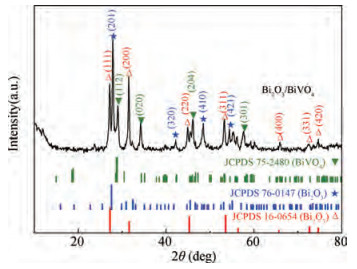
 DownLoad:
DownLoad:
